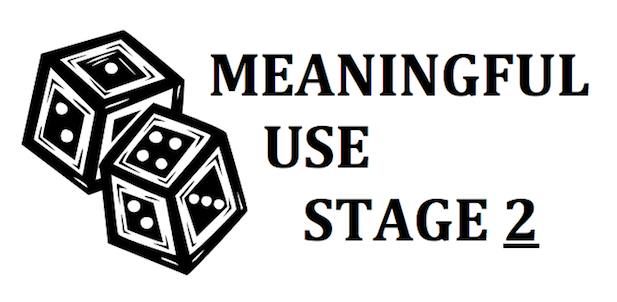Starting October 1st, there will be a year long reporting cycle implemented for those healthcare organizations that still need to attest to Meaningful Use Stage 2. One reason for this change in the reporting timeline was simply that the vast majority of providers just aren’t ready.
Starting October 1st, there will be a year long reporting cycle implemented for those healthcare organizations that still need to attest to Meaningful Use Stage 2. One reason for this change in the reporting timeline was simply that the vast majority of providers just aren’t ready.
Meaningful Use Stage 2
Meaningful Use Stage 2 requires that eligible professionals attest to 20 core objectives as set forth by CMS. The full list is several pages and runs the gamut of measures from clinical process to cyber-security. The latter of course already having been projected to be a hot topic in healthcare for 2015.

Straight from the horse’s mouth, if you will, take a look at how many of those core measures are directly related to EHR/EMR mandates:
- Computerized physician order entry (CPOE) for orders as follows:
- >60% of medication,
- 30% of laboratory and 30% of radiology E-Prescribing (eRx) for > 50% of the permissible scripts for patients for whom the EHR was used
- Implement 5 clinical decision support interventions for 4+ CQM.
- Drug–drug and drug-allergy interaction checks turned on Provide >50% of all unique patients seen with online access to their health information within 4 business days.
- >5% of patients view download or transmit to a 3rd party their health information.
- Provide > 50% of patients seen with the EHR, a clinical summary within 1 business day
- Record demographics as structured data on >80% of all patients seen: preferred language, gender, race, ethnicity, DOB > 80% of all patients age 3 and above have blood pressure recorded and of all patients have height and weight recorded as structured data.
- Record >80% of patients smoking status for patients 13 years or older and seen with the EHR.
- Ensure adequate privacy and security protections for personal health information.
- Conduct or review a security risk analysis including addressing the encryption/security of data at rest and implement security updates as necessary and correct identified security deficiencies.
- > 55% of clinical lab test results are stored as structured data for patients seen with the EHR Generate at least one report of patients by specific conditions to use for quality improvement, reduction of disparities, research or outreach.
- Use EHR to identify and send an appropriate reminder per patient preference for preventive/follow up care for > 10% of patients with 2+ office visits in the last 2 years
- > 10% of all patients seen are provided patient-specific education resources identified through use of certified EHR technology.
- Performs medication reconciliation on > 50% of transitions of care or relevant encounters for EHR patients.
- EP who transitions or refers the patient seen with the EHR to another setting of care will provide a summary of care record for > 50% of transitions and referrals.
- The EP transmits the summary electronically either a) directly using certified EHR technology or b) through an ONC valid exchange.
- Also the EP must also conduct one data exchange using a certified EHR technology that is different from the receiving EP or conduct 1+ test with a CMS designated test EHR.
- On an ongoing basis, successfully submit with certified EHR technology immunization data to immunization registries/systems.
- Successfully send secure electronic messages through certified EHR technology to >5% of all unique patients seen.
Feeling daunted? You’re not alone. This is only part one of the list, but it provides an overview of what the focus for providers and hospitals will need to be in 2015 if the majority of them want to be able to attest before the year is out.
Why so behind?
If you’re wondering how it is that so many providers and organizations are behind, consider this: while most healthcare professionals understand that the electronic medical record is more than just a flash in the pan, many of the practicing physicians it will impact in the short term assume that they’ll retire before the dream of “one patient, one record” is fully realized.
So, their resistance and soft-peddling of the required training and technology has slowed the process. Similarly, in the C-Suite those who are tasked with weighing the financial consequences of rolling out an EMR too soon often don’t consider what the outcome will be if they get on the bandwagon too late.
Government Change
In 2015 several pieces of key legislation are up for consideration regarding cyber-security and the protection of patient information that could be made vulnerable by the increase in EMR usage and Health Information Exchanges (HIE). Currently, the FDA’s role in regulating health IT is unclear. Several of the bills to be considered this year beg the question: what power, if any, should the federal government have where patient data is concerned?
Among these acts to be considered are the SOFTWARE Act, The Telemed Enhancement Act, The Medicare Teleheath Parity Act and the TELEMED Act. The latter would allow providers to treat patients in any of the 50 states with just one license. While the specifics of each endeavor vary, the overarching theme is one that isn’t unique to the healthcare sector: would government involvement in patient data create more problems?
Considering the pressure on providers and organizations to attest to Meaningful Stage 2, which is contingent upon the technology being considered — and potentially threatened — by lawmakers, it’s no surprise that the future of health IT is one of the hottest topics in the industry this year. Not only is it weighing heavily on the minds of providers and hospitals, but patients too.
The healthcare IT discussion may well be the first one where the risk/benefit analysis is not just undertaken by industry professionals, but patients as well. Since so much of the data will be either patient reported, or contingent upon wearable tech and/or patient participation in data-mining initiatives, one reason so many seem to be struggling to attest to stage 2 Meaningful Use might just be that there are so many perspectives to consider.
In Conclusion
What’s ahead in terms of the legislation remains to be seen, but one thing is clear: the clock is ticking on attestation and the real meaning behind Meaningful Use is still out of reach for many.
The post The Meaning of Meaningful Use appeared first on BHM Healthcare Solutions.







